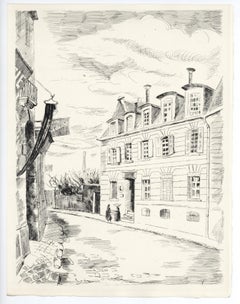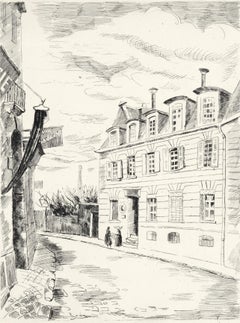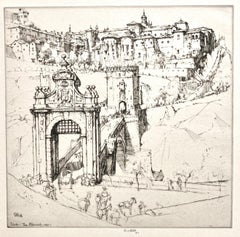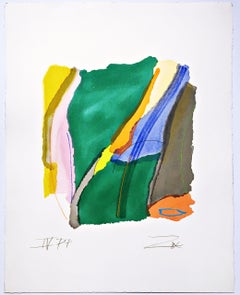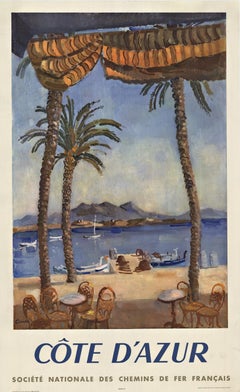Edmond Céria Art
French, 1884-1955
Edmond Céria was born in Évian-les-Bains (Haute-Savoie). Céria studied at the Académie Julian. He exhibited with the Salon des Artistes Indépendants from 1907, the Salon d'Automne from 1912, and with the Salon des Tuileries from its foundation in 1925. Solo exhibitions included shows at the Galerie Bernheim in Paris and the Wildenstein Gallery in New York.
to
1
3
Overall Width
to
Overall Height
to
3
1
2
2
3
3
3
2
1
1
1
1
1
3
6
7,820
5,167
2,504
1,501
2
1
Artist: Edmond Céria
"Songes de Passy" original etching
By Edmond Céria
Located in Henderson, NV
Medium: original etching. This impression on Canson et Montgolfier wove paper was printed in 1937 in an edition of 500 for the "Paris 1937" portfolio. Printed at the atelier of Jean-...
Category
1930s Edmond Céria Art
Materials
Etching
Songes de Passy, A La gloire à Paris, Edmond Céria
By Edmond Céria
Located in Auburn Hills, MI
Etching on vélin Canson et Montgolfier paper. Unsigned and unnumbered, as issued. Good condition. Published by L'Imprimerie Daragnès, Paris; printed by Jean Gabriel Daragnès, Paris, July 14, 1937. Notes: From the folio, A La gloire à Paris, 1937. Excerpted from the folio (translated from French), The Glory of Paris. This dedicated album by the Paris municipality was written, illustrated, engraved and printed in the year MCMXXXVII. This album was decorated and printed by J.-G. Daragnes for the City of Paris. This album has been completed to print on Vélins des Manufactures de Canson et Montgolfier et des Papeteries on July 14, 1937, D examples, the first CC of which were reserved for the subscribers of the album.
EDMOND CÉRIA (1879-1954) From his childhood, Edmond Ceria showed a predisposition for music, drawing and painting. After studying at the Évian college, he entered the Geneva School of Fine Arts. Disappointed by teaching, he went to Paris in 1904, entered the Académie Julian and attended the Louvre museum where he discovered the work of Paul Cézanne which shocked him. He becomes a disciple of this new vision of the world, where sensitivity and love of nature replace genre and anecdote. According to René Barotte, “its incisive pages are reminiscent of Guardi or Canaletto. His style gradually frees itself from a certain rigor in execution. The touch becomes a sign, almost an ideogram, and the small painting appears written like a love poem. He began his career by exhibiting at the Salon des Indépendants in 1908, then at the Salon des Tuileries and the Salon d'Automne of which he was a member. In 1919, he spent a year in Tuscany which made him aware, like Corot, of the importance of light in painting. During this stay, he copied the great Italian masters including Giotto, Uccello, Masaccio. Back in France, Ceria discovered the light of Provence, painting mainly in Marseille and Sanary. In Paris, he set up in a workshop near the Observatory and frequently went down to the quays to paint the Seine, the bridges, the Concorde, the Tuileries and the Luxembourg. In 1934, he stopped his travels in Provence to discover Brittany where he spent many years. Indifferent to fashions and unfailingly attached to the nature that he stylizes, he pursues a landscape work whose light touches highlight the accidents or reflections. When the climate forced him to paint in the studio, he devoted his talent to still lifes, which testify to his love of life, just as his landscapes reflect his taste for nature. Ceria participated, with his friends Charles Dufresne, Othon Friesz and Henry de Waroquier, in the first exhibition of the Masters of Independent Art at the Petit Palais in 1937. Always alongside Dufresne, to whom he entrusted the artistic education of his son Jacques Despierre, he decorated the small foyer of the Chaillot theater with Le Théâtre...
Category
1930s Modern Edmond Céria Art
Materials
Etching
Edmond Céria - Paris, Quais de Orfèvres - Original Etching
By Edmond Céria
Located in Collonge Bellerive, Geneve, CH
Charles Martin - The Eiffel Tower - Original Lithograph
Dimensions : 13 x 10".
Paper : Rives vellum.
Edition : 225 copies.
1927
From Tableaux de Paris, Emile-Paul Freres, Pari...
Category
1920s Modern Edmond Céria Art
Materials
Etching
Related Items
Ernest David Roth, Toledo, The Approach
By Ernest David Roth
Located in New York, NY
Working in the tradition of the Etching Revival, Ernest David Roth made this amazingly conceived and detailed study of the entrance to the Spanish ci...
Category
Early 20th Century American Modern Edmond Céria Art
Materials
Etching
IV unique Printers Proof Color field geometric abstraction pencil signed pochoir
By Larry Zox
Located in New York, NY
Larry Zox
Untitled IV, ca. 1979
Pochoir on Arches Paper with Deckled Edges. Hand signed and annotated Printers Proof in pencil on the lower front.
28 1/2 × 22 1/2 inches
Unframed
This beautiful Larry Zox pochoir on Arches paper with deckled edges a unique Printers Proofs - signed by the artist in pencil on the lower front.
We do not know the size of the regular edition, or whether there is a regular edition, but this is indeed a unique PP.
LARRY ZOX BiIOGRAPHY
A painter who played an essential role in the Color Field discourse of the 1960s and 1970s, Larry Zox is best known for his intensely and brilliantly colored geometric abstractions, which question and violate symmetry. Zox stated in 1965: “Being contrary is the only way I can get at anything.” To Zox, this position was not necessarily arbitrary, but instead meant “responding to something in an examination of it [such as] using a mechanical format with X number of possibilities.”[2] What he sought was to “get at the specific character and quality of each painting in and for itself,” as James Monte stated in his introductory essay in the catalogue for Zox’s 1973–74 solo exhibition at the Whitney Museum of American Art.[3] Zox also at times used a freer, more intuitive method, while maintaining coloristic autonomy, which became increasingly important to him in his later career.
Zox began to receive attention in the 1960s, when he was included in several groundbreaking exhibitions of Color Field and Minimalist art, including Shape and Structure (1965), organized by Henry Geldzahler and Frank Stella for Tibor de Nagy, New York, and Systemic Painting (1966), organized by Lawrence Alloway for the Guggenheim Museum. In 1973–74, the Whitney’s solo exhibition of Zox’s work gave recognition to his significance in the art scene of the preceding decade. In the following year, he was represented in the inaugural exhibition of the Hirshhorn Museum, which acquired fourteen of his works.
Zox was born in Des Moines, Iowa. He attended the University of Oklahoma and Drake University, and then studied under George Grosz at the Des Moines Art Center. In 1958, Zox moved to New York, joining the downtown art scene. His studio on 20th Street became a gathering place for artists, jazz musicians, bikers, and boxers. He occasionally sparred with visiting fighters. He later established a studio in East Hampton, a former black smithy used previously by Jackson Pollock.
Zox’s earliest works were collages consisting of pieces of painted paper stapled onto sheets of plywood. He then produced paintings that were illusions of collages, including both torn- and trued-edged forms, to which he added a wide range of strong hues that created ambiguous surfaces. Next, he omitted the collage aspect of his work and applied flat color areas to create more complete statements of pure color and shape. He then replaced these torn and expressive edges with clean and impersonal lines that would define his work for the next decade.
From 1962 to 1965, he produced his Rotation series, at first creating plywood and Plexiglas reliefs, which turned squares into dynamic polygons. He used these shapes in his paintings as well, employing white as a foil between colors to produce negative spaces that suggest that the colored shapes had only been cut out and laid down instead of painted. The New York Times noted in 1964: “The artist is hip, cool, adventurous, not content to stay with the mere exercise of sensibility that one sees in smaller works.”[4]
In 1965, he began the Scissors Jack series, in which he arranged opposing triangular shapes with inverted Vs of bare canvas at their centers that threaten to split their compositions apart. In several works from this series, Zox was inspired by ancient Chinese water vessels. With a mathematical precision and a poetic license, Zox flattened the three dimensional object onto graph paper, and later translated his interpretation of vessel’s lines onto canvas with masking tape, forming the structure of the painting.
The Diamond Cut and Diamond Drill paintings...
Category
1970s Color-Field Edmond Céria Art
Materials
Etching, Pencil, Monoprint
Paul Klee Etching "Die Szene mit der Laufenden"
By (after) Paul Klee
Located in Berlin, DE
Helio-etching on hand-made paper, 1925 by Paul Klee. Signatur is printed, lower right: Klee
From portfolio Paul Klee, Handzeichnungen 1921-1930; Here no 28
Image: 5.63 x 7.48 in ( 14...
Category
Early 20th Century Expressionist Edmond Céria Art
Materials
Etching
S. L Margolies, Silent Symphony
Located in New York, NY
S. L Margolies (Samuel L.) made dynamic urban views and calm country scenes. This peaceful subject, with snow-covered hills and tidy cabin, Silent Symphony, 1946, marks an end to the...
Category
Mid-20th Century American Modern Edmond Céria Art
Materials
Etching
Morning
By Alex Katz
Located in New York, NY
1994, color aquatint, 48 x 36 inches, edition of 40
Although best known for his portraits, Katz has depicted landscapes both inside the studio and out of doors since the beginning o...
Category
1990s Edmond Céria Art
Materials
Etching, Aquatint, Intaglio
Paul Klee Etching "Möchten sollen"
By Paul Klee
Located in Berlin, DE
Helio-etching on hand-made paper, 1927 by Paul Klee. From portfolio "Paul Klee, Handzeichnungen 1921-1930" Here no 41
Measurements: Image: 5.51 x 7.48 in ( 14 x 19 cm ), Framed: 13.4...
Category
Early 20th Century Expressionist Edmond Céria Art
Materials
Etching
Irving Guyer, Christmas Trees on Second Street (NYC)
By Irving Guyer
Located in New York, NY
Philadelphia-born Irving Guyer attended the Art Students League and worked in New York City before moving to California. This print is signed and titled i...
Category
1930s American Modern Edmond Céria Art
Materials
Drypoint, Etching
Untitled #5
By Thomas Nozkowski
Located in New York, NY
2012, 4-plate aquatint with 22 colors, 21 7/8 x 29 3/8 inches, edition of 25
For over thirty years, Nozkowski has practiced his own form of idiosyncratic abstraction, foregoing a si...
Category
21st Century and Contemporary Edmond Céria Art
Materials
Aquatint
Kent Hagerman, (US Air Force Fairchild C-119, the 'Flying Boxcar')
By Kent Hagerman
Located in New York, NY
While this is probably a military airport, Kent Hagerman still shows it at its futuristic best. Hagerman was an amazing draftsman who managed to get fantastic detail into his work.
This is really a portrait of a plane -- the Fairchild C-119. The words 'United States Air Force' on the side of the plane date it to 1947 or later, after the Air Force split from the Army. The design featured the 'twin boom' clearly showing in this etching. Thanks to this feature it was called the Flying Boxcar. About 1100 were built and used until 1955. It was also used by the Chinese Air...
Category
Mid-20th Century American Modern Edmond Céria Art
Materials
Etching
Paul Klee Etching "Stilistisch"
By Paul Klee
Located in Berlin, DE
Helio-etching on hand-made paper, 1923 by Paul Klee. Signatur is printed, lower center: Klee
From portfolio Paul Klee, Handzeichnungen 1921-1930; Here no 15
Image: 5.55 x 7.48 in ( 1...
Category
Early 20th Century Expressionist Edmond Céria Art
Materials
Etching
Amorpha (Color), Surrealist Etching by Frantisek Kupka
By Frantisek Kupka
Located in Long Island City, NY
Frantisek Kupka, Czech (1871 - 1957) - Amorpha (Color). Year: 1913, Medium: Color Etching on Richard de Bas, stamp signed, Image Size: 9 x 5.75 inches, Size: 20.25 x 12.75 in. (51.44...
Category
1910s Surrealist Edmond Céria Art
Materials
Etching
The Loop III (the artist's memories of days at Chicago's Art Institute)
By Richard Gilbert
Located in New Orleans, LA
The Loop III was created in a small edition of 15. The Loop is a vibrant area featuring eclectic eateries, shops, theaters and parks. Comprised mostly of high-rises, it’s also home to the 108-story Willis Tower. The iconic “Cloud Gate...
Category
1990s Modern Edmond Céria Art
Materials
Etching
Previously Available Items
Original Cote d'Azur vintage French travel poster
By Edmond Céria
Located in Spokane, WA
Original French vintage travel poster: COTE D'AZUR . Linen backed and ready to frame. A- with touch up of the boarder when the poster was linen backed.
Original, archival linen backed, French travel poster...
Category
1950s American Realist Edmond Céria Art
Materials
Lithograph
Edmond Céria art for sale on 1stDibs.
Find a wide variety of authentic Edmond Céria art available for sale on 1stDibs. You can also browse by medium to find art by Edmond Céria in paper, etching and more. Much of the original work by this artist or collective was created during the 20th century and is mostly associated with the modern style. Not every interior allows for large Edmond Céria art, so small editions measuring 10 inches across are available. Customers who are interested in this artist might also find the work of Lucien Philippe Moretti, Louis Claude, and Giovanni Pintori. Edmond Céria art prices can differ depending upon medium, time period and other attributes. On 1stDibs, the price for these items starts at $701 and tops out at $1,297, while the average work can sell for $1,083.
